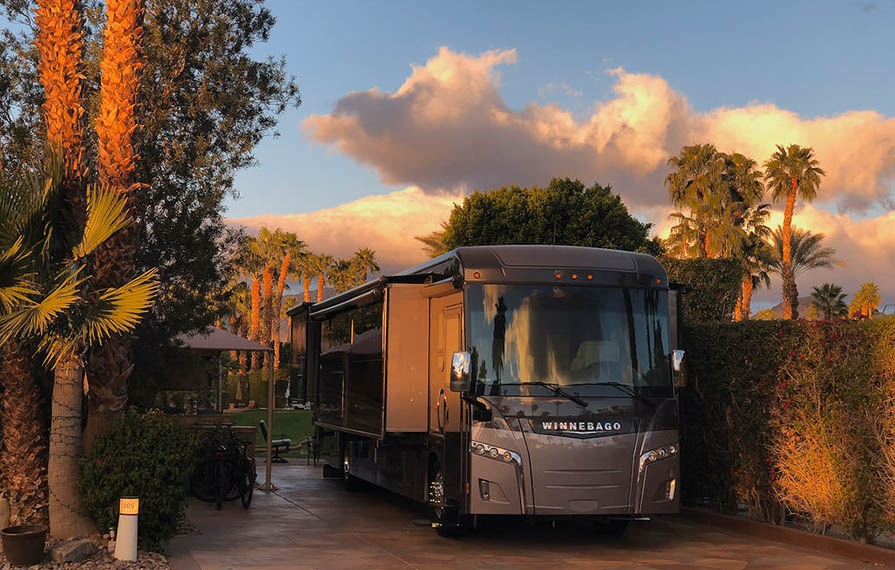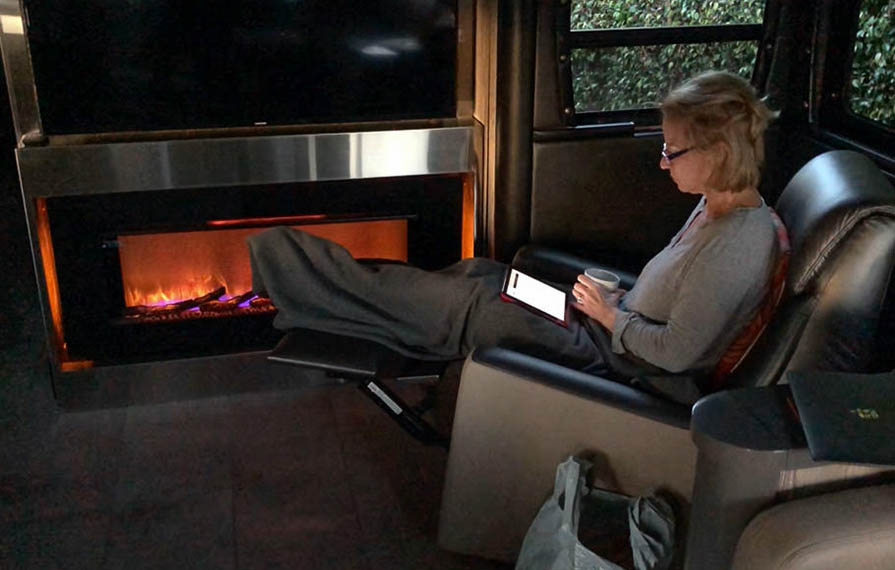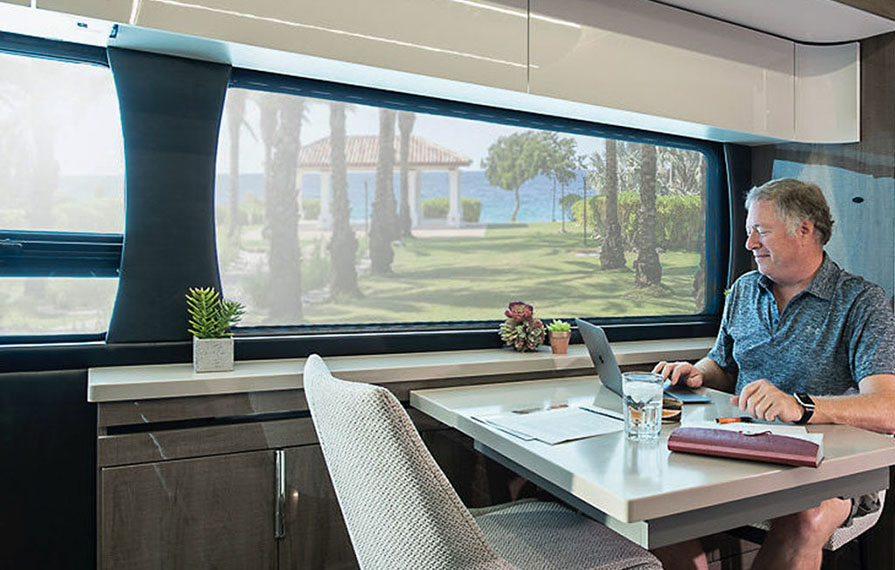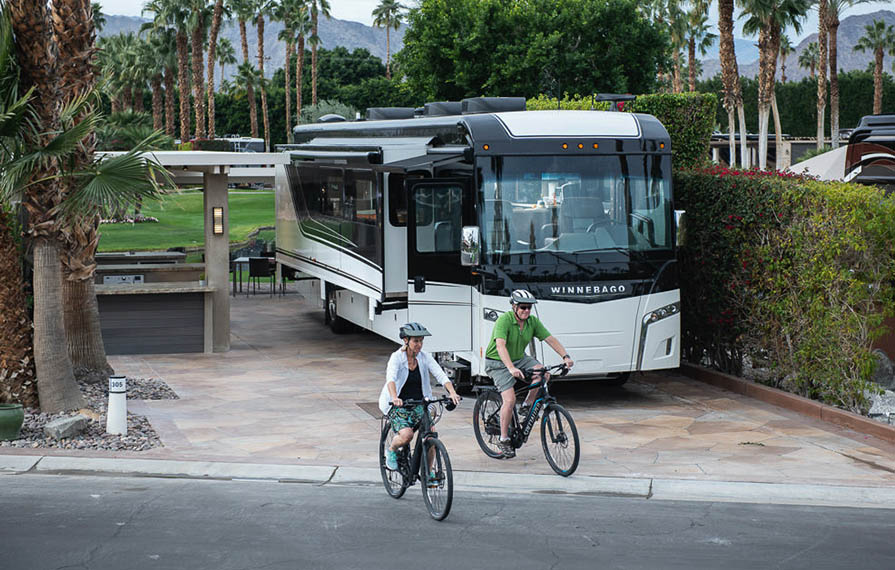
Inside Big-Ticket RV Purchases
Inside Big-Ticket RV Purchases
Tips, strategies, & wisdom to help make better, more confident financial decisions.
By: Don Cohen

Few things concentrate the mind as writing a substantial six-figure check. The time had finally arrived to decide if we’d turn our extended field testing of the Horizon into actual ownership. From the get-go, it was something we had always anticipated. But now, as the dealer documents appeared on e-mail, the moment had come.
In the pantheon of large life purchases, the Horizon price ranked above our first three homes, but well below future ones. It was an amount we couldn’t have fathomed affording thirty-seven years ago when we got married and bought our first home for $62,000. Over nearly four decades, as many people often do, we found ourselves occasionally standing in front of big financial decisions. Of the hundreds of articles that have appeared on WinnebagoLife, very few deal with the far less sexy and romantic aspects of cost of ownership, but the hard reality is that all the dreams and exciting experiences on this blog are fueled by money.
Talking About Money
Whether it’s custom, courtesy, or simply humility, there seems to be a veil of inappropriateness in talking about the financial mechanics of a large purchase such as a motorhome. The curiously timid won’t ask you the price but may look up your rig on RV Trader. The bolder might ask you how much you paid. Assuming you’re both RV owners, that question puts you both at risk, worrying that it might reveal that one or the other of you paid too much. And then there’s the killer question that everybody wants to know, but is absolutely too afraid to ask: How could you afford it? That takes you into the delicate private realm of financial disclosure. Verboten!
Everyone’s financial picture is different. It’s a mixture of assets, income, risk tolerance and life goals. Throughout our lives these variables often change in importance. Fun opportunities can appear and just as quickly be exploded by an unpleasant health or career setback. Risk management is a term large businesses use to plan for known and unexpected downsides. If you’ve ever bought life insurance, set up a retirement plan, or purchased a service repair policy, you’ve made a risk management decision.
Analyzing Affordability
So, let’s get back to the key question: Can I afford this? In the process of buying a big-ticket RV, that’s really the second step of the journey. The first is the dream step. It’s where your mind first opens to the possibility of buying a rig and acting on it. There are three types of dream phases. The first is the slow build where intrigue builds into interest over time as you research, toy with, and mull over options and opportunities. The second is the emotional whim. It’s close to a love-at-first-sight moment and often is described to friends as a, “you’ll never believe what we just did” kind of story. Third, is a combination of the two, the calculated whim. The romance and idea of buying an RV take hold, but you test your emotions by waiting to see if the fever will break as you poke holes in the plan. Depending where you are on the life curve, your analytic approach and sensitivity to risk will likely change.

Once you’ve gotten comfortable with the idea of a purchase, the affordability question looms large. I asked several owners how they approached this step.
Real Owner Examples
Davis and his wife, Karen, had been boat owners for many years. With the experience of having a 42’ cruiser, a motorhome purchase was very similar. “You need to buy it like it will be your last,” Davis said. He researched floorplans and models carefully. A couple of years into ownership of their coach, he realized that there were many items he’d overlooked in his purchase evaluation, such as quality of workmanship, which had manifested themselves into a continuing fix list. After three years of ownership, his “last” motorhome got traded in for a far more expensive and luxurious brand. And this one, he hopes, is much better built and could be the “last” one. At age 68, that may be true, but many couples in their seventies find themselves driving off the lot with a new coach they fell in love with.
After retiring from a successful thirty-year career in the tech industry, Miles and Lynne sold both their primary and secondary residences and bought a new diesel pusher to go full-time. They banked the equity from the home sales and allocated a portion to buying a motorhome. “The downsizing was a killer,” Lynne recalls. “We had two homes, one being 5,000 square feet. But after we got rid of everything, it felt pretty liberating.” Like Davis, Miles had thought their new rig was “the one.” Both Miles and Lynne love to cook and a front forward galley design really appealed to them. However, two years later they were in another larger, and more upscale coach.
“What happened?” I asked. Miles paused a moment to consider his answer, “Well, we realized that the window on being younger and active was getting smaller and this was something for us that would make us happy.”
A frequent chuckle line when coach owners get together is, “we’re spending our kid’s inheritance.” In fact, when the conversation turns serious, that’s not the case. In the hierarchy of fiscal responsibilities, fun is usually several notches lower than financial independence and generational wealth transfer. How couples approach that balance calculation differs.
In the case of Bob and Sally, the gating factor was their retirement income. Together, their pension incomes peaked just under $150,000 a year. Early in their retirement they bought a forty-foot diesel pusher and started spending four to five months in a warmer climate. They found a good snowbird community and after a couple of years, determined that they would be comfortable in selling their home and living full-time in the RV.
Bob described their thinking: “As long as we remain healthy, we think this is a five to seven-year plan. Thinking about our living costs, we financed about forty percent of the purchase. That keeps our monthly payment pretty reasonable and certainly, in five to seven years, we’d expect the depreciated sale of the motorhome will pay off the loan. In the meantime, we’ve banked the sales proceeds from our home and when we’re ready to settle back down we’ll look at either buying a home near our kids, or maybe even keeping it simpler and renting.”
Our Motorhome Purchasing History
In our own experience, our first Navion purchase was driven by the downsizing of selling our mountain home and making our downtown condo our primary residence. The sale proceeds of our house went into our brokerage account and I held out $125,000 for a motorhome purchase. Two years later, the high resale value of our Navion allowed us to roll forward into a new Navion with many improved features and a different floorplan. Buying the second one came with a new clarity of field experience that made knowing what to look for in systems and decisions of floorplans a lot easier. Proportionally to our income and assets, buying the Navions wasn’t a hard or complex decision.
The Horizon was a different kettle of fish. The larger acquisition cost would leave a discernable dent in our assets and the on-going overhead in RV resort homeowner’s association fees, taxes, insurance, and storage would put a $15,000 a year weight on our annual cash flow. It was enough that a spreadsheet was required.

A Spreadsheet-Worthy Decision
I smiled when Miles told me that, before they bought their most recent coach, he’d presented Lynne with a spreadsheet analysis. I’d done the same thing for Terry. I modeled a variety of options.
The first was acquisition cost. As I had done with our first Navion purchase, I had made a grid of dealers and prices which helped me establish a baseline discount. Given a good sense of what our purchase price would likely be, I created several scenarios with different down payments ranging from 20% to 60% across amortizations of 5, 7, and 10 years. With some quick internet research, I found a fairly consistent interest rate I could then crank in to show me what monthly payments looked liked.
I also compared the cost of borrowing against paying cash, so I could see the difference in the cost of borrowing a portion for the purchase and then investing the balance. With interest rates continuing to remain low, it may be that you can get a higher return on your money if it’s invested. Let’s say you can finance at 5%, but find an investment returning 7%. That potentially nets you a 2% differential. Sounds reasonable, doesn’t it? On $100,000 that’s $2,000 a year or potentially $14,000 over the life of a seven-year loan.
But there are a few asterisks that follow. First, these days, it’s very hard to find investments that will yield guaranteed returns that are 2% over prevailing interest rates and you may not be able to lock in for the longer duration. Furthermore, this strategy assumes you’re disciplined enough not to touch your investment over time.
Picking a Purchase Strategy
If you are going to finance, the absolute worst time to be working out rates and payments are when you’re sitting in a dealer finance office. True, many dealers have good pre-negotiated rates with lenders. Years ago, when buying a car, I called my banker for a rate quote. My car broker came back with a rate that was 2% lower from my same bank! However, you may find a better rate, term, and payback flexibility with a Heloc (home equity loan). Generally, Heloc’s are put together just like a mortgage, so be prepared for about a month of time, lots of documentation, and a few hundred dollars of fees. Once your line of credit is in place, you can activate it when you’re ready to purchase. That’s what I did.
As we were approaching a final call on the purchase, I took another look at our cash situation. Over the months, as we were contemplating the purchase, our cash position strengthened to the point that we decided to write a check for the entire amount. Throughout my business career I have aggressively used debt many times and in many ways. However, in our personal finances, we’ve been far more conservative. Debt is something to best be avoided, even if it means a bit of dream deferral. If you make a big RV purchase that’s north of $100,000, make sure that your income stream is secure enough to handle financing costs. If you’re retired, you want to keep debt costs low, or non-existent. Later in life isn’t the time to increase risk.
And speaking of risk, here’s a novel strategy worth considering. When buying a coach, dealers may offer you extended service plans. They’re not cheap and the majority of service plan buyers rarely file claims. However, consider insuring yourself instead. I’m suggesting an inexpensive term life policy that would unburden your spouse or children of paying off an outstanding loan, or supplemental income insurance if you’re injured or ill and are facing the drain of monthly payments.
Figure all of this out ahead of time, and by the time you’re in the finance manager’s office, you’ll be much better equipped to say yes or no to finance options.

Planning for Costs
One of the other spreadsheets I built was an analysis of on-going costs. A core analysis that businesses use when developing budgets is the identification of fixed and variable costs. Our next evolution of RV life was going to have some stepped up fixed costs. For fixed costs, we were going to take on the on-going monthly expenses related to buying a lot at an RV resort. That would include HOA fees, utilities, landscaper, property taxes, and insurance. Additionally, we also needed to arrange for storage for the Horizon when we were back home. Two other fixed costs were insurance and ownership taxes (license plates). Adding all of them up gave me a predictable and repeatable baseline of expenses.
Then there were the variable costs. These include fuel, camping/hook-up fees, repairs, and replacement. For the days we would be using the Horizon for mobile traveling (versus staying in one place during the winter), I made a rough estimate of days and multiplied them times a per day rate. Everyone’s per day rates are probably different. Establishing your own personal per day rate is like a golfer playing multiple rounds to establish a handicap. On your next trip, add up your camping fees, fuel, food and special expenses (tours, entrance fees, etc.) and then divide the total by the number of days of your trip. Frugal RVers will find that per day rate to come in around $50. On the luxe side, that rate will likely fall between $100 to $150.
Another variable cost is repair/replacement. Many owners use a simple rule of thumb of calculating 1% to 2% of the purchase price for annual maintenance. While a good starting point, you can probably get to a more precise number by inquiring from a dealer what an annual engine tune-up is and any other ongoing “house” preventive maintenance tasks. If you want to go one level deeper, look at things like tire replacement where you can estimate the cost of replacing tires (based on your use) in X amount of years.
Preparing an Exit
The final spreadsheet analysis was the exit strategy. While far more speculative, I built several scenarios of what unwinding this lifestyle journey might look like. At the core, was a hard-nosed look at the depreciation of the coach. I built 3, 5, 7, and 10-year columns that showed not only depreciation, but annual carrying/operating costs. At the end of these different periods, I could get a sense of how much of my capital I might get back and restoration of income with the elimination of ongoing expenses. A good way to think about depreciation is that it’s the non-recoverable cost of having fun. If you take a long trip or go on a cruise, you don’t get your money back, but you have the memories and photos to enjoy in the future.
Benefits of Crunching the Numbers
Now all these steps and calculations may hit you as being pointless, mind-numbing, or even depressing. Granted, they’re tedious. However, there is a huge upside — the more you understand the financial aspects of your choice, the less worry you’ll have in the future. When confronted by a substantial purchase decision, your best insurance is careful analysis. It’s much better to identify weaknesses on paper, than having to confront the discomfort of a nasty financial surprise in the future. While there are no guarantees in life, honest analysis will go a long way in minimizing both risk and the worry that comes with it.
Comments
Comments on this post are moderated, so they will not appear instantly. All relevant questions and helpful notes are welcome! If you have a service inquiry or question related to your RV, please reach out to the customer care team directly using the phone numbers or contact form on this page .